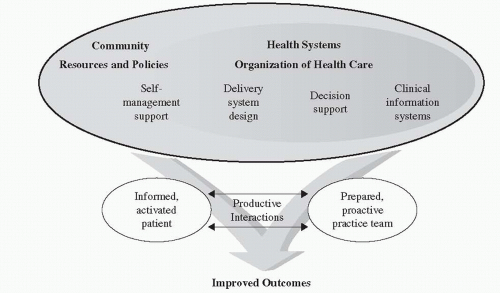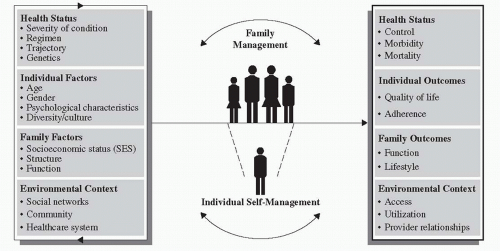The home healthcare industry delivers a variety of services to individuals with chronic health problems living in homes within communities. Services can be divided into two types: 1) skilled healthcare providers, under the direction of a physician’s order and supported by third-party reimbursement, and 2) “supportive community services” (SCS), including support for instrumental activities of daily living and personal care (
Capitman, 2003). Individuals and agencies provide SCS on a fee-for-service basis. It is common that healthcare providers and SCS workers simultaneously provide services to clients, often through the same agency. The focus of this chapter is on the roles of nurses and other skilled healthcare providers in the home.
Home health nurses provide nursing care to clients with acute and/or chronic illnesses, as well as meet the terminal care needs of clients in their place of residence. The overall goal of care is to enhance quality of life or support clients at the end of life (
American Nurses Association [ANA], 2008). Home health nurses use holistic strategies to work with clients, families, and informal caregivers to manage disease or disability. They practice highly independently, often being the only professional care provider in the home. The specialty of home health nursing differs from other nursing specialties in that care is provided in the client’s home; the duration and frequency of care is dependent upon the care delivery model and the holistic needs of the client, family, and caregivers; and the nurse must have advanced knowledge of healthcare payment systems and cost containment (
ANA, 2008).
History of Home Care
William Rathbone, a wealthy British businessman and philanthropist, founded the first district nursing association. The district nursing services combined therapeutic nursing care and education for healthful living practices. Working with Florence Nightingale, he advocated for district nursing throughout England in the mid 1880s (
Stanhope & Lancaster, 2010) and founded a visiting nurses training school to ensure that nurses had the necessary knowledge and skills to work successfully in a community setting (
Hitchcock, Schubert, & Thomas, 2003).
The visiting nurse model established in England was adapted by the United States as a means of addressing some of the serious public health problems of the late 19th century. Large American cities faced many challenges associated with increasing numbers of immigrants entering the country. Poverty-stricken communities with congested living conditions quickly gave rise to epidemics of infectious diseases such as
tuberculosis, smallpox, scarlet fever, typhoid, and typhus (
Schoen & Koenig, 1997).
The first visiting nurse associations (VNAs) to provide care in the needy person’s home were established in the United States in Buffalo (1885), Philadelphia (1886), and Boston (1886). Charitable activities, supported by wealthy people, funded settlement houses and early VNAs. One of the early settlement houses in the United States began through the efforts of Lillian Wald and Mary Brewster (
Stanhope & Lancaster, 2010).
Funded by the Metropolitan Life Insurance Company (
Murkofsky & Alston, 2009), Lillian Wald and Mary Brewster revolutionized the concept of public health nursing (
Hitchcock et al., 2003). Lillian Wald is credited with developing the title
public health nurse, and with that title the focus of nursing care was broadened to encompass not just the health of individuals but also the health, social, and economic needs of the community as a whole. In 1893 Wald and Brewster co-founded the first organized public health nursing agency, New York City’s Henry Street Settlement. The settlement house provided a unique combination of social work, nursing, and social activism (
Schoen & Koenig, 1997). The focus was public education to improve maternal and child health, communicable disease control, nutrition, and mental health. By 1911 Metropolitan Life Insurance Company had established the first national system of insurance for home care (
Murkofsky & Alston, 2009).
The roles of the visiting nurse and public health nurse became more distinct by the late 1920s. Visiting nurses, employed by the private sector and financed by charity and public contributions, clearly were the “hands-on” providers of bedside nursing care in the home setting. Public health nurses, employed primarily by government health departments, focused their attention on promoting health and preventing disease in the broader community. Although their areas of concentration differed, both groups of nurses functioned independently in the delivery of nursing care outside of an institutional setting and shared the common goal of promoting, maintaining, and restoring health in the community (
Hitchcock et al., 2003; see
Table 20-1).
Successes achieved by the collective efforts of visiting nurses, public health nurses, and public health services created a shift in the focus of health care in the first half of the 20th century. Successes in teaching hygiene and decreases in immigration reduced the threat of communicable disease. Success in the community combined with advances in technology and hospital care led to changes in the populations served by home health nurses. During the 1930s and 1940s, fewer clients received care from visiting nurses (
Reichley, 1999). However, hospitals quickly realized that although they were the providers of acute care, they were also becoming the providers of care for individuals with longterm chronic disorders. As a result, hospitals began searching for ways to control the increasing costs incurred by chronic illness care.
Establishment of New York City’s Montefiore Hospital Home Care Program in 1947 provided one alternative to care of clients needing healthcare interventions outside of an acute care setting. The Montefiore Program, a “Hospital Without Walls,” created a model of hospital-linked, home-delivered care utilizing the professional services of physicians, nurses, and social workers (
Gundersen, 1999). This hospital-based homecare model demonstrated significant cost savings over in-hospital care and served as the catalyst for the resurgence of home health care as we know it today (
Reichley, 1999). The focus for home care from Montefiore was not only the clients’ illness, with its subsequent chronic state, but also their
holistic needs. Social workers addressed the clients’ social needs and overall well-being and were interested in clients’ families, including their role in providing for the clients’ health care (
Lundy & Janes, 2001).
For more than half a century, philanthropists, public charities, and contributions raised by the VNAs funded homecare services. In 1966 the federal government began providing for homecare services as a benefit of the new legislation known as Medicare. Medicare allowed for the expansion of homecare services to many people, particularly the elderly who did not have access to such care. In 1973 the Medicare homecare benefit was expanded to include disabled Americans regardless of age. However, homecare advocates became increasingly concerned that the narrowness of homecare legislation limited services as a means of avoiding the excessive costs of providing the full range of services that many clients needed (
Reichley, 1999).
Between 1980 and 1996 the home healthcare industry experienced a 400% increase in Medicare-sponsored home care. During that time
period, the number of agencies certified to bill Medicare rose by 200% (
Montauk, 1998). This was a direct result of many reimbursement changes affecting hospitals. In an effort to control the cost of care in acute care hospitals, Congress passed the Social Security Amendments of 1983 to initiate the prospective payment system (PPS) for inpatient services (
Stanhope & Lancaster, 2010). Therefore, federal government shifted reimbursement to a PPS based on diagnosis-related groups (DRGs). With reimbursement for hospital care now predetermined by client diagnosis, hospitals responded to the significant revenue reductions by decreasing the average length of stay for clients. The direct consequence was shorter hospital stays and increased referrals to home care (
Stanhope & Lancaster, 2010).
However, in 1997 Congress targeted home health care as a place to reduce healthcare expenditures. The passage of the Balanced Budget Act of 1997 (BBA) imposed stricter limits on Medicare reimbursement for homecare services and required the Medicare administration to develop a PPS (
Murkofsky & Alston, 2009). The BBA narrowed the definition of those individuals eligible to receive homecare services to those individuals who were deemed “homebound.” Under these guidelines, Medicare recipients were no longer eligible for home care if they were able to leave home for any reason other than medical services (
Maurer & Smith, 2005). The number of persons eligible for Medicare homecare funding declined by 50% between 1997 and 2000 (
Maurer & Smith, 2005). Today, the industry continues to provide holistic care in a fiscally restrained environment. Under the PPS implemented in 2000, agencies were paid a set amount for each 60-day episode of care regardless of the number of visits provided. These payments are case-mix adjusted so the agency received more money for clients requiring more care (
Murkofsky & Alston, 2009).





